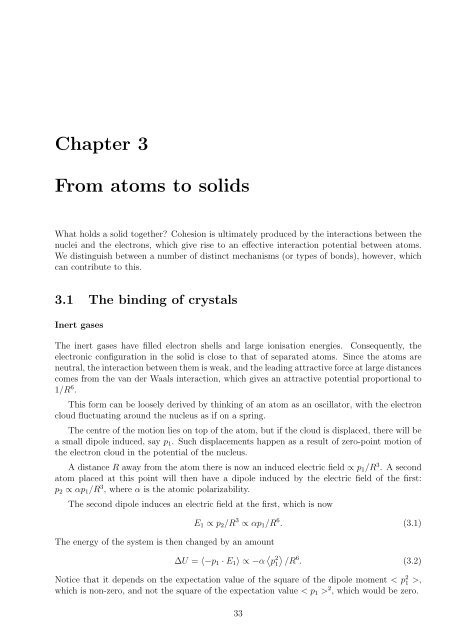Set of supplementary notes.
Set of supplementary notes.
Set of supplementary notes.
You also want an ePaper? Increase the reach of your titles
YUMPU automatically turns print PDFs into web optimized ePapers that Google loves.
Chapter 3<br />
From atoms to solids<br />
What holds a solid together Cohesion is ultimately produced by the interactions between the<br />
nuclei and the electrons, which give rise to an effective interaction potential between atoms.<br />
We distinguish between a number <strong>of</strong> distinct mechanisms (or types <strong>of</strong> bonds), however, which<br />
can contribute to this.<br />
3.1 The binding <strong>of</strong> crystals<br />
Inert gases<br />
The inert gases have filled electron shells and large ionisation energies. Consequently, the<br />
electronic configuration in the solid is close to that <strong>of</strong> separated atoms. Since the atoms are<br />
neutral, the interaction between them is weak, and the leading attractive force at large distances<br />
comes from the van der Waals interaction, which gives an attractive potential proportional to<br />
1/R 6 .<br />
This form can be loosely derived by thinking <strong>of</strong> an atom as an oscillator, with the electron<br />
cloud fluctuating around the nucleus as if on a spring.<br />
The centre <strong>of</strong> the motion lies on top <strong>of</strong> the atom, but if the cloud is displaced, there will be<br />
a small dipole induced, say p 1 . Such displacements happen as a result <strong>of</strong> zero-point motion <strong>of</strong><br />
the electron cloud in the potential <strong>of</strong> the nucleus.<br />
A distance R away from the atom there is now an induced electric field ∝ p 1 /R 3 . A second<br />
atom placed at this point will then have a dipole induced by the electric field <strong>of</strong> the first:<br />
p 2 ∝ αp 1 /R 3 , where α is the atomic polarizability.<br />
The second dipole induces an electric field at the first, which is now<br />
The energy <strong>of</strong> the system is then changed by an amount<br />
E 1 ∝ p 2 /R 3 ∝ αp 1 /R 6 . (3.1)<br />
∆U = 〈−p 1 · E 1 〉 ∝ −α 〈 p 2 1〉<br />
/R 6 . (3.2)<br />
Notice that it depends on the expectation value <strong>of</strong> the square <strong>of</strong> the dipole moment < p 2 1 >,<br />
which is non-zero, and not the square <strong>of</strong> the expectation value < p 1 > 2 , which would be zero.<br />
33








